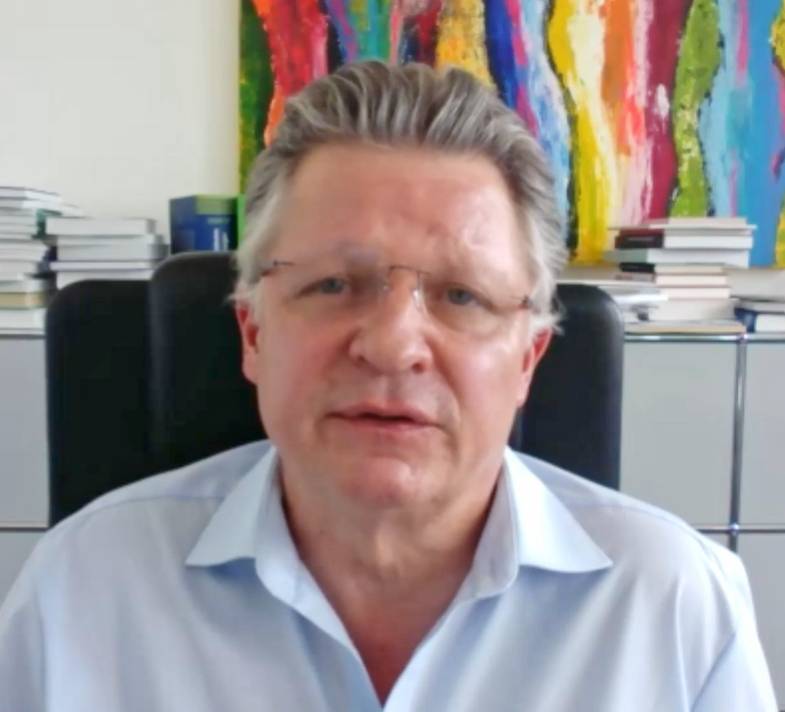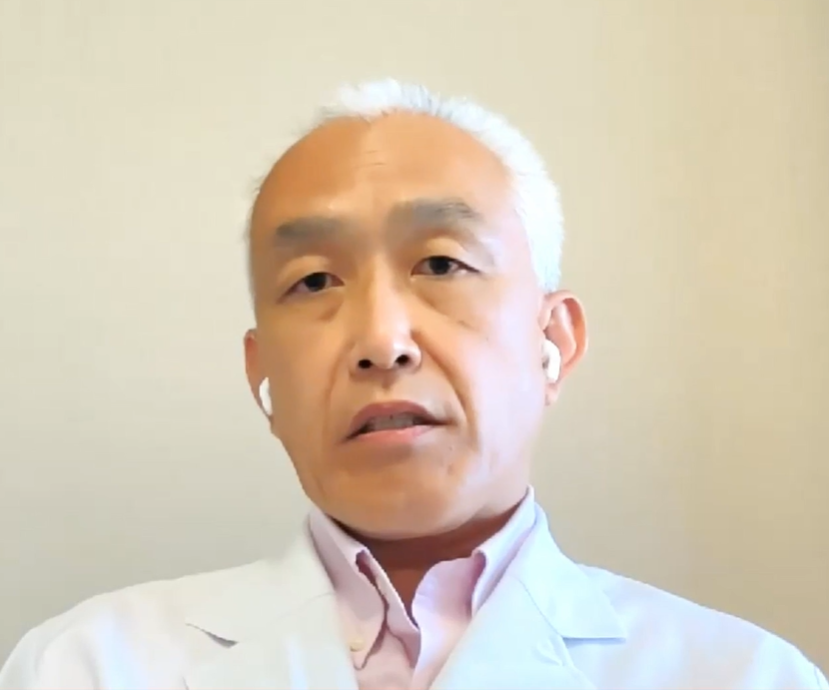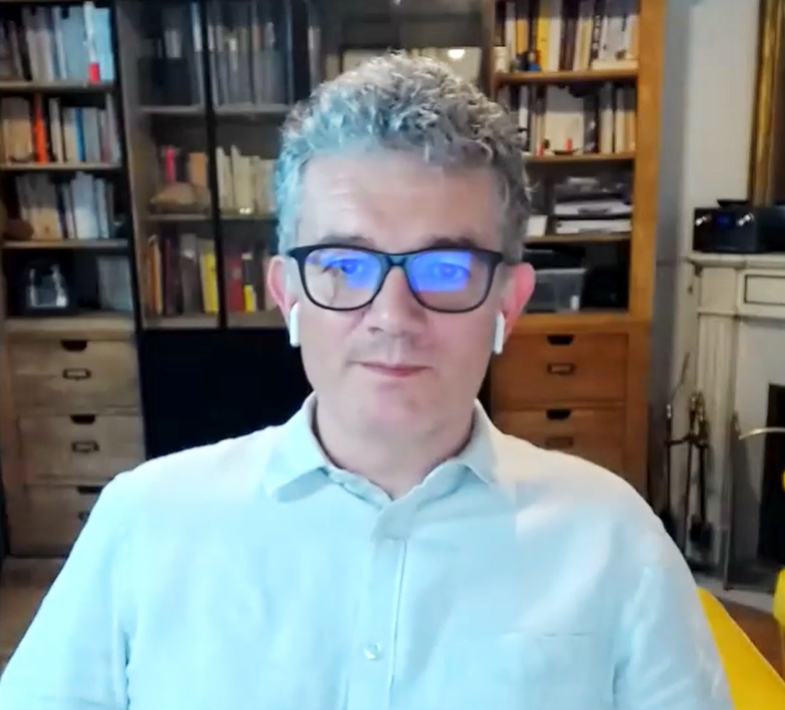touchEXPERT BRIEFING Recent updates in the field of Alzheimer’s disease
Watch leading experts discuss recent developments in Alzheimer’s disease, including the use of biomarkers.
Prof. Dr Frank Jessen discusses best practice approaches to the diagnosis of Alzheimer’s disease and the importance, particularly for patients, of a timely and accurate diagnosis.
1/3 Next InterviewIn this interview, we asked Prof. Dr Frank Jessen the following questions:
- What would be the optimal patient pathway when suspecting an early symptomatic Alzheimer’s disease?
- What is the value of using biomarkers of Alzheimer’s disease pathology?
- Discuss which biomarkers should be used in the diagnosis and staging of Alzheimer’s disease.
- How can we outline the importance to patients of a timely and accurate biological diagnosis of Alzheimer’s disease, and its value to inform shared decision-making around therapy?
- How can we keep up with the pace of innovation and still have Alzheimer's disease diagnostic guidelines that remain adapted to the current understanding of science?
Dr Atsushi Iwata discusses the current and potential future utility of plasma and CSF biomarkers in the clinical diagnosis and prognosis of AD.
2/3 Next InterviewIn this interview, we asked Dr Atsushi Iwata the following questions:
- Why is a timely diagnosis for Alzheimer’s disease essential for patients and their families?
- How can Alzheimer’s disease biomarkers contribute to timely diagnosis?
- How useful are blood-based biomarkers (BBM) in predicting amyloid and tau brain pathology, and cognitive decline?
- What are the critical steps to implementing fluid biomarkers into clinical routines for the management of AD?
- Which blood-based biomarkers might be of greatest interest in the diagnostic workup of patients and facilitate disease management?
Dr Benoît Delatour provides commentary on recent progress in understanding the pathophysiology of AD including the contribution of LATE-NC co-morbidity, the role of microglia, changes in wake promoting neurons and the role of gonadotropin-releasing hormone.
3/3 Leave FeedbackIn this interview, we asked Dr Benoît Delatour the following questions:
- Describe the contribution of LATE comorbidity to Alzheimer’s disease. Is there a synergistic effect between brain pathologies?
- What is the role of microglia activation and tau pathology in Alzheimer’s disease?
- What insights into the overall pathology of Alzheimer’s disease can findings in the retina provide?
- How could changes in wake-promoting neurons help to understand the sleep disturbances observed in Alzheimer’s disease?
- Discuss the possible role of GnRH in Alzheimer’s disease and associated pathologies.
Overview & Learning Objectives
Overview
Knowledge of the pathophysiology of Alzheimer’s disease (AD) is rapidly evolving, reflected by the increased focus on using biomarkers for disease diagnosis and staging. In this activity, leading experts discuss recent developments in our understanding of AD pathophysiology, including the use of biomarkers.
Learning Objectives
After watching this activity, participants should be better able to:
- Understand recent progress in understanding the pathophysiology of AD, including the contribution of LATE-NC co-morbidity, the role of microglia, change in wake promoting neurons and the role of GnRH
- Describe best practice approaches to the diagnosis of AD and the importance, particularly for patients, of a timely and accurate diagnosis
- Discuss the current and potential future utility of plasma and CSF biomarkers in the clinical diagnosis and prognosis of AD
Faculty & Disclosures

Prof. Dr Frank Jessen
Department of Psychiatry, University of Cologne, Cologne, Germany
Prof. Dr Frank Jessen received his MD degree from the University of Saarland in 1995. After residencies in neuropathology at the University of Düsseldorf, and neurology and psychiatry at the University of Bonn, he was board certified as a psychiatrist and psychotherapist in 2002. He served from 2002-2010 as a consultant psychiatrist and head of clinical Alzheimer’s disease research at the Department of Psychiatry, University of Bonn. In 2010, he was appointed Professor of Clinical Dementia Research and deputy director of the Department of Psychiatry, University of Bonn. In 2015, he was appointed as a Professor of Psychiatry and Psychotherapy and director of the Department of Psychiatry, University of Cologne. Since 2010, he has been an associate researcher and group leader for Clinical Alzheimer Research at the German Center of Neurogenerative Diseases (DZNE).
Prof. Dr Jessen’s research focuses on prevention, early diagnosis and treatment of Alzheimer’s disease with expertise in neuropsychology, neuroimaging, epidemiology and genetics. He coordinated national and international multicenter observational studies and clinical trials. He is a member of the board of the Germany Psychiatric Association (DGPPN), for which he coordinates the German national guideline on the diagnosis and treatment of dementia (S3-guideline dementia).
Prof. Dr Frank Jessen discloses:
Fees for advice and presentations (2019–2023) from Abbie, AC Immune, Biogen, Danone/Nutricia, Eisai, Eli Lilly, GE Healthcare, Grifols, Janssen and Roche. Funding from BMBF, BZGA, DFG, DZNE, Eranet Neuron, Horizon 2020, IMI, IHI, Innovationfonds (GBA) and JPND. Membership of German Association of Psychiatry (DGPPN, member of the board), German Association of Biological Psychiatry (DGBP), German Association of Geriatrics (DGGPP), German Memory Clinic Network (DNG, Chair), European Alzheimer’s disease Consortium (EADC, Chair). Scientific advisory board member for German Alzheimer Association, Hirnliga Alzheimer Europe

Dr Atsushi Iwata
Tokyo Metropolitan Institute for Geriatrics and Gerontology, Tokyo, Japan
Dr. Atsushi Iwata received his medical degree from the University of Tokyo. After medical training and neurology residency at several hospitals, he became certified neurologist of Japanese society of Neurology. He then entered graduate school of medicine at the University of Tokyo. After receiving his Ph.D., he moved to Stanford University to study autophagy and protein aggregation as a pos-doc. He continued post-doctoral training back in the University of Tokyo and started his own laboratory from the year 2008.
Now a Project Associate Professor at the University of Tokyo, he serves as a general neurologist, as well as behavioral neurologist at the memory clinic. He is also conducting early detection of memory disorders in the medical check-up unit and conducting various clinical studies on Alzheimer’s disease at the University of Tokyo hospital.
His current research aims to elucidate pathomechanisms of sporadic neurodegenerative disorders through epigenetics and molecular biology. He is also involved in various clinical studies on Alzheimer’s disease and serving as a scientific board member for various pharmaceutical industries.
Dr Atsushi Iwata discloses:
Speaker fees and/or research grants from, and has been a member of advisory boards for Eisai and Shionogi. Speaker fees from and has been a member of advisory boards for Janssen Pharmaceuticals, Chugai-Roche, and Merck Sharp & Dohme. Speaker fees and research grants from Otsuka Pharmaceutical Co Ltd, Daiichi Sankyo Company Ltd, and One Pharmacreutical Co Ltd. Speaker fees from Kyowa Kirin Co Ltd, UCB Japan, and Eli Lilly. Research grants from AbbVie, Dainippon Sumitomo, the Japan Agency for Medical Research and Development, and the Japan Society for the Promotion of Science.

Dr Benoît Delatour
Centre national de la recherche scientifique (CRNS), Institut du Cerveau (ICM) Paris, France
Dr Benoît Delatour joined CNRS in 2002. His scientific interests were initially focused on the study of the functions of the hippocampal-prefrontal system in rodents that he addressed using multidisciplinary approaches (behavioural analysis of brain-lesioned animals; anatomical tracing studies to investigate topographical organization of neural systems). His research then rapidly evolved to the study of memory disorders related to pathological conditions (AD and associated pathologies such as Down’s syndrome, DS). Initiated by morphological analysis in postmortem tissue from human patients, this work presently relies on the in vivo study of mice models of the disease through neuroimaging, histological and behavioral approaches. Recent interest for DS has been driven by the obvious relationships that exist between AD and DS pathologies (at the neuropathological and genetic levels).
Dr Delatour’s research activity has always been carried out in a pluridisciplinary context, relying on active partnership with scientists developing various technical and conceptual expertise (molecular biology, small animal MR imaging, applied chemistry, biophysics etc.) and working in both academic and industrial backgrounds.
Dr Benoît Delatour discloses:
Speaker fees from Eli Lilly.
References
- Porsteinsson AP, Isaacson RS, Knox S, et al. Diagnosis of Early Alzheimer's Disease: Clinical Practice in 2021. J Prev Alzheimers Dis 2021; 8(3): 371–86.
- Iliffe S, Robinson L, Brayne C, et al. Primary care and dementia: 1. diagnosis, screening and disclosure. Int J Geriatr Psychiatry 2009; 24(9): 895–901.
- Paraskevaidi M, Morais CLM, Lima KMG, et al. Differential diagnosis of Alzheimer's disease using spectrochemical analysis of blood. Proc Natl Acad Sci U S A 2017; 114(38): E7929–e38.
- Luebke M, Parulekar M, Thomas FP. Fluid biomarkers for the diagnosis of neurodegenerative diseases. Biomark Neuropsychiatry 2023; 8: 100062.
- National Institute on Aging and Alzheimer’s Association. NIA-AA Revised Criteria for Diagnosis and Staging of Alzheimer's Disease. Available at: https://alz.org/media/Documents/scientific-conferences/NIA-AA-Clinical-Criteria-for-Staging-and-Diagnosis-for-Public-Comment-Draft-2.pdf (accessed November 2023).
- Andersen E, Casteigne B, Chapman WD, et al. Diagnostic biomarkers in Alzheimer’s disease. Biomark Neuropsychiatry 2021; 5: 100041.
- Tian M, Civelek AC, Carrio I, et al. Molecular Imaging-based Precision Medicine Task Group of A3 (China-Japan-Korea) Foresight Program. International consensus on the use of tau PET imaging agent 18F-flortaucipir in Alzheimer's disease.Eur J Nucl Med Mol Imaging 2022; 49: 895–904.
- Dubois B, Padovani A, Scheltens P, et al. Timely Diagnosis for Alzheimer's Disease: A Literature Review on Benefits and Challenges. J Alzheimers Dis 2016; 49(3): 617–31.
- Liss JL, Seleri Assunção S, Cummings J, et al. Practical recommendations for timely, accurate diagnosis of symptomatic Alzheimer's disease (MCI and dementia) in primary care: a review and synthesis. J Intern Med 2021; 290(2): 310–34.
- Daly RL, Bunn F, Goodman C. Shared decision-making for people living with dementia in extended care settings: a systematic review. BMJ Open 2018; 8: e018977.
- Jessen F, Bohr L, Kruse C, et al. Die S3-Leitlinien Demenzen [The German S3 guidelines on dementia]. 2023; 94(7): 609–613.
- Henriksen MJV, Wienecke T, Thagesen H, et al. Assessment of Residents Readiness to Perform Lumbar Puncture: A Validation Study. J Gen Intern Med 2017; 32: 610–618.
- Salvadó G, Vogel B, Binette V, et al. Novel CSF tau biomarkers can be used for disease staging of sporadic Alzheimer’s. AAIC 2023, Amsterdam, The Netherlands, July 16-20.
- Barthélemy NR. et al. Plasma tau phosphorylation at T217 predicts amyloid deposition in dominantly inherited and late onset Alzheimer disease participants without clinical symptoms. AAIC 2023, Amsterdam, The Netherlands, July 16–20
- Cummings J. The Role of Biomarkers in Alzheimer's Disease Drug Development. Adv Exp Med Biol. 2019; 1118: 29–61.
- Hansson O, Edelmayer RM, Boxer AL, et al. The Alzheimer's Association appropriate use recommendations for blood biomarkers in Alzheimer's disease. Alzheimer's Dement 2022; 18: 2669–2686.
- Hlavka JP, Mattke S, Liu JL. Assessing the Preparedness of the Health Care System Infrastructure in Six European Countries for an Alzheimer's Treatment. Santa Monica, CA: RAND Corporation; 2018.
- Meneses A, Koga S, O’Leary J, et al. TDP-43 Pathology in Alzheimer’s Disease. Molecular Neurodegeneration 2021; 16(1): 84.
- Nelson PT, Dickson DW, Trojanowski JQ, et al. Limbic-predominant age-related TDP-43 encephalopathy (LATE): consensus working group report. Brain 2019; 142(6): 1503–27.
- Wang SJ, Guo Y, Ervin JF, et al. Neuropathological associations of limbic-predominant age-related TDP-43 encephalopathy neuropathological change (LATE-NC) differ between the oldest-old and younger-old. Acta Neuropathol 2022; 144(1): 45–57.
- Woodworth DC, Nguyen KM, Bukhari SA, et al. Association of LATE-NC with other neuropathologies and cognition in the oldest-old: Evidence from The 90+ Study and NACC. AAIC 2023, Amsterdam, The Netherlands, July 16–20.
- Tomé SO, Tsaka G, Ospitalieri S, et al. The impact of co-morbid LATE-NC pathology in Alzheimer’s Disease. AAIC 2023, Amsterdam, The Netherlands, July 16–20.
- Leng F, Edison P. Neuroinflammation and microglial activation in Alzheimer disease: where do we go from here? Nat Rev Neurol 2021; 17(3): 157–72.
- Hart de Ruyter FJ, Morrema THJ, den Haan J, et al. Phosphorylated tau in the retina correlates with tau pathology in the brain in Alzheimer's disease and primary tauopathies. Acta Neuropathol 2023; 145(2): 197–218.
- Hart de Ruyter FJ MT, Haan J, Twisk JWR. Retinal phosphorylated tau correlates with the presence of microglia in Alzheimer’s disease and primary tauopathies. AAIC 2023, Amsterdam, The Netherlands, July 16-20.
- Grimaldi A, Pediconi N, Oieni F, et al. Neuroinflammatory Processes, A1 Astrocyte Activation and Protein Aggregation in the Retina of Alzheimer's Disease Patients, Possible Biomarkers for Early Diagnosis. Front Neurosci 2019; 13: 925.
- Berron D, Vogel JW, Insel PS, et al. Early stages of tau pathology and its associations with functional connectivity, atrophy and memory. Brain 2021; 144(9): 2771–2783.
- Zhang F, Zhong R, Li S, et al. Alteration in sleep architecture and electroencephalogram as an early sign of Alzheimer's disease preceding the disease pathology and cognitive decline.Alzheimer’s Dement. 2019; 15: 590–597.
- Son G, Mladinov M, Tu C-L ea, . Selective vulnerability of the suprachiasmatic nucleus in progressive Alzheimer’s Disease: A human postmortem study using spatial in-situ proteomics. AAIC 2023, Amsterdam, The Netherlands, July 16–20.
- Liguori C, Spanetta M, Izzi F, et al. sleep-Wake Cycle in Alzheimer's Disease Is Associated with Tau Pathology and Orexin Dysregulation. J Alzheimers Dis 2020; 74(2): 501-508.
- Lew CH, Petersen C, Neylan TC, et al. Tau-driven degeneration of sleep- and wake-regulating neurons in Alzheimer's disease. Sleep Med Rev 2021; 60: 101541.
- Oh J, Eser RA, Ehrenberg AJ, et al. Profound degeneration of wake-promoting neurons in Alzheimer's disease. Alzheimers Dement. 2019; 15(10): 1253–1263.
- Ranasinghe KG, Cha J, Iaccarino L, et al. Neurophysiological signatures in Alzheimer's disease are distinctly associated with TAU, amyloid-β accumulation, and cognitive decline. Sci Transl Med. 2020;12(534): eaaz4069.
- Prevot V ea. Unlocking cognition with pulsatile GnRH in Down Syndrome: implications for Alzheimer's disease. AAIC 2023, Amsterdam, The Netherlands, July 16–20.
- Head E, Lott IT, Wilcock DM, et al. Aging in Down Syndrome and the Development of Alzheimer's Disease Neuropathology. Curr Alzheimer Res 2016; 13(1): 18–29.
- Manfredi-Lozano M, Leysen V, Adamo M, et al. GnRH replacement rescues cognition in Down syndrome. Science 2022; 377(6610): eabq4515.

